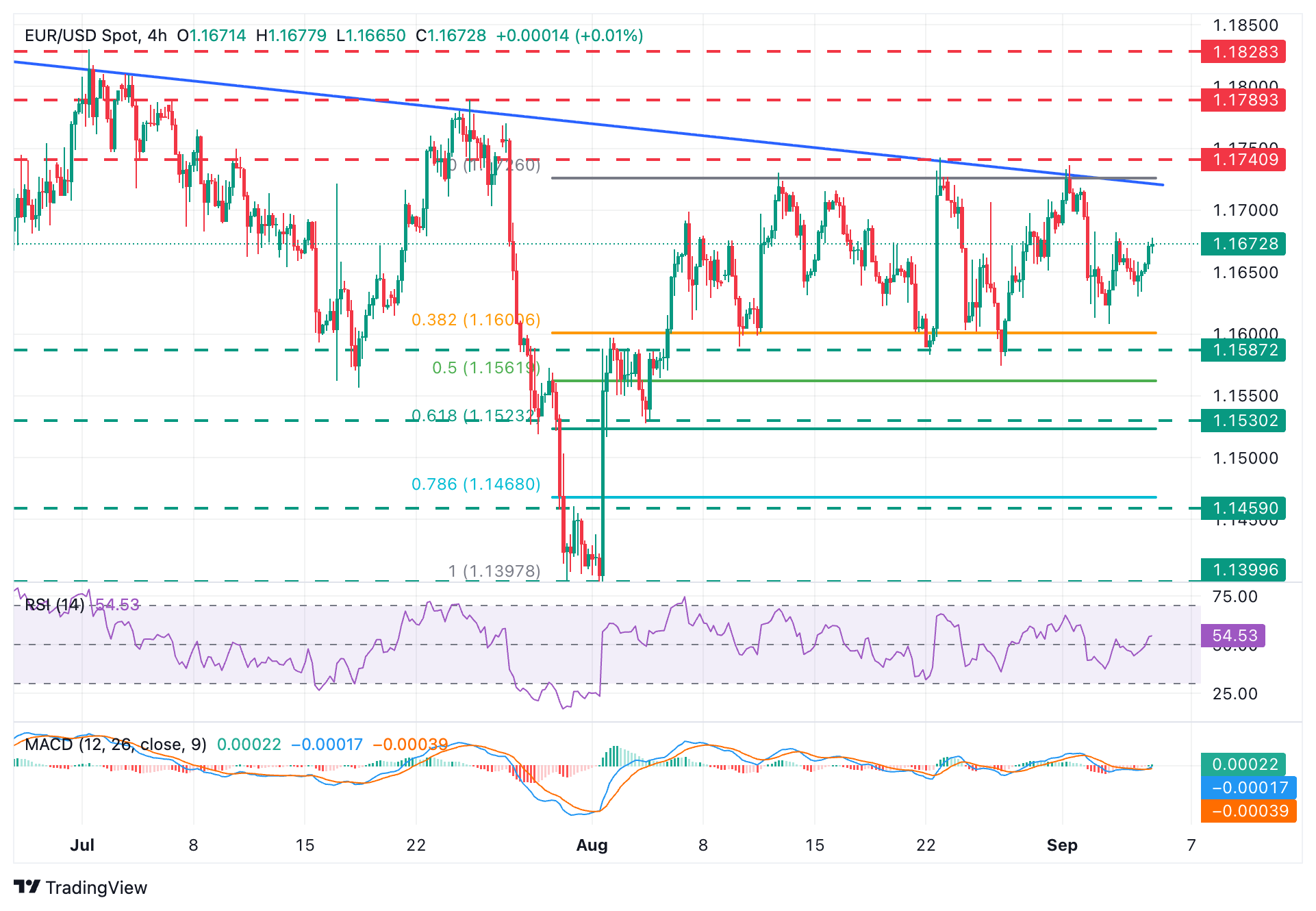Created
: 2025.09.05














![]() 2025.09.05 16:43
2025.09.05 16:43
The EUR/USD pair is trading moderately higher on Friday, currently at 1.1677, but still on track for its second consecutive negative week. Market hopes of a Federal Reserve (Fed) interest rate cut keep a mild risk appetite alive, yet with the US Dollar's (USD) sales limited ahead of the US Nonfarm Payrolls report.
Investors are hoping for a relatively soft NFP report later in the day to cement market expectations of a Fed rate cut in September. US weekly Initial Jobless Claims data and the ADP report both pointed to a weaker labor market on Thursday, endorsing those views.
Comments from Federal Reserve officials have leaned to the dovish side this week. New York Fed President John Williams affirmed on Thursday that he sees "gradual rate cuts," and Chicago Fed President Austan Goolsbee reiterated that September's meeting will be "live" after warning about the deterioration of the labour market.
Bets about lower interest rates in the US have helped to ease the bond market crisis seen earlier in the week. In Europe, the German and French 30-year yields have retreated from Wednesday's lows, although they remain at relatively high levels.
In the Eurozone economic calendar, the focus this Thursday is on the employment change and the final reading of the Q2 Gross Domestic Product (GDP). Investors, however, will be more attentive to the US Nonfarm Payrolls report for confirmation of a Fed rate cut in September.
The table below shows the percentage change of Euro (EUR) against listed major currencies today. Euro was the strongest against the US Dollar.
| USD | EUR | GBP | JPY | CAD | AUD | NZD | CHF | |
|---|---|---|---|---|---|---|---|---|
| USD | -0.22% | -0.24% | -0.12% | -0.11% | -0.38% | -0.36% | -0.21% | |
| EUR | 0.22% | -0.00% | 0.00% | 0.11% | -0.07% | -0.12% | 0.01% | |
| GBP | 0.24% | 0.00% | 0.06% | 0.11% | -0.05% | -0.13% | 0.06% | |
| JPY | 0.12% | 0.00% | -0.06% | 0.09% | -0.17% | -0.20% | 0.09% | |
| CAD | 0.11% | -0.11% | -0.11% | -0.09% | -0.21% | -0.25% | -0.07% | |
| AUD | 0.38% | 0.07% | 0.05% | 0.17% | 0.21% | -0.08% | 0.12% | |
| NZD | 0.36% | 0.12% | 0.13% | 0.20% | 0.25% | 0.08% | 0.18% | |
| CHF | 0.21% | -0.01% | -0.06% | -0.09% | 0.07% | -0.12% | -0.18% |
The heat map shows percentage changes of major currencies against each other. The base currency is picked from the left column, while the quote currency is picked from the top row. For example, if you pick the Euro from the left column and move along the horizontal line to the US Dollar, the percentage change displayed in the box will represent EUR (base)/USD (quote).

The EUR/USD technical picture shows a building positive trend, although bullish momentum remains frail. The 4-hour Relative Strength Index keeps wavering back and forth around the 50 level, and the MACD indicator is showing a lack of clear momentum.
On the upside, bulls are likely to be challenged at the September 3 high of 1.1682. Beyond here, the descending trendline resistance, now around 1.1720 and the 1.1735 area, which capped rallies on August 13 and 22, and September 1, is likely to pose a significant resistance.
Immediate support is at Thursday's low near 1.1630 ahead of the September 3 low, right above 1.1610. Further down, the area between 1.1575 and 1.1590, which held bears on August 11, 22, and 27, and is also the floor of the last four weeks' trading range.
Labor market conditions are a key element to assess the health of an economy and thus a key driver for currency valuation. High employment, or low unemployment, has positive implications for consumer spending and thus economic growth, boosting the value of the local currency. Moreover, a very tight labor market - a situation in which there is a shortage of workers to fill open positions - can also have implications on inflation levels and thus monetary policy as low labor supply and high demand leads to higher wages.
The pace at which salaries are growing in an economy is key for policymakers. High wage growth means that households have more money to spend, usually leading to price increases in consumer goods. In contrast to more volatile sources of inflation such as energy prices, wage growth is seen as a key component of underlying and persisting inflation as salary increases are unlikely to be undone. Central banks around the world pay close attention to wage growth data when deciding on monetary policy.
The weight that each central bank assigns to labor market conditions depends on its objectives. Some central banks explicitly have mandates related to the labor market beyond controlling inflation levels. The US Federal Reserve (Fed), for example, has the dual mandate of promoting maximum employment and stable prices. Meanwhile, the European Central Bank's (ECB) sole mandate is to keep inflation under control. Still, and despite whatever mandates they have, labor market conditions are an important factor for policymakers given its significance as a gauge of the health of the economy and their direct relationship to inflation.
![]()
Created
: 2025.09.05
![]()
Last updated
: 2025.09.05

FXStreet is a forex information website, delivering market analysis and news articles 24/7.
It features a number of articles contributed by well-known analysts, in addition to the ones by its editorial team.
Founded in 2000 by Francesc Riverola, a Spanish economist, it has grown to become a world-renowned information website.
We hope you find this article useful. Any comments or suggestions will be greatly appreciated.
We are also looking for writers with extensive experience in forex and crypto to join us.
please contact us at [email protected].
Disclaimer:
All information and content provided on this website is provided for informational purposes only and is not intended to solicit any investment. Although all efforts are made in order to ensure that the information is correct, no guarantee is provided for the accuracy of any content on this website. Any decision made shall be the responsibility of the investor and Myforex does not take any responsibility whatsoever regarding the use of any information provided herein.
The content provided on this website belongs to Myforex and, where stated, the relevant licensors. All rights are reserved by Myforex and the relevant licensors, and no content of this website, whether in full or in part, shall be copied or displayed elsewhere without the explicit written permission of the relevant copyright holder. If you wish to use any part of the content provided on this website, please ensure that you contact Myforex.
Myforex uses cookies to improve the convenience and functionality of this website. This website may include cookies not only by us but also by third parties (advertisers, log analysts, etc.) for the purpose of tracking the activities of users. Cookie policy